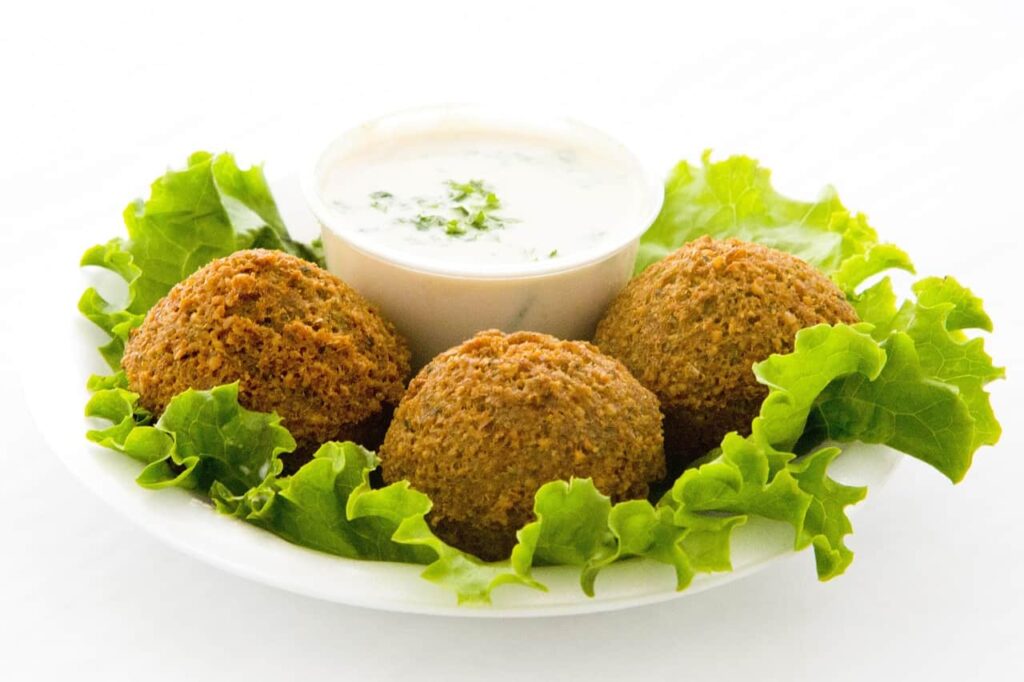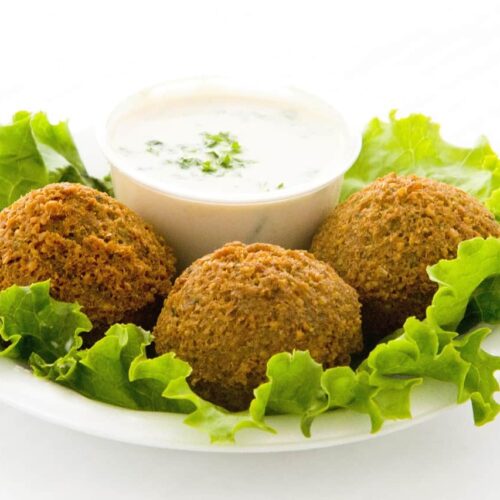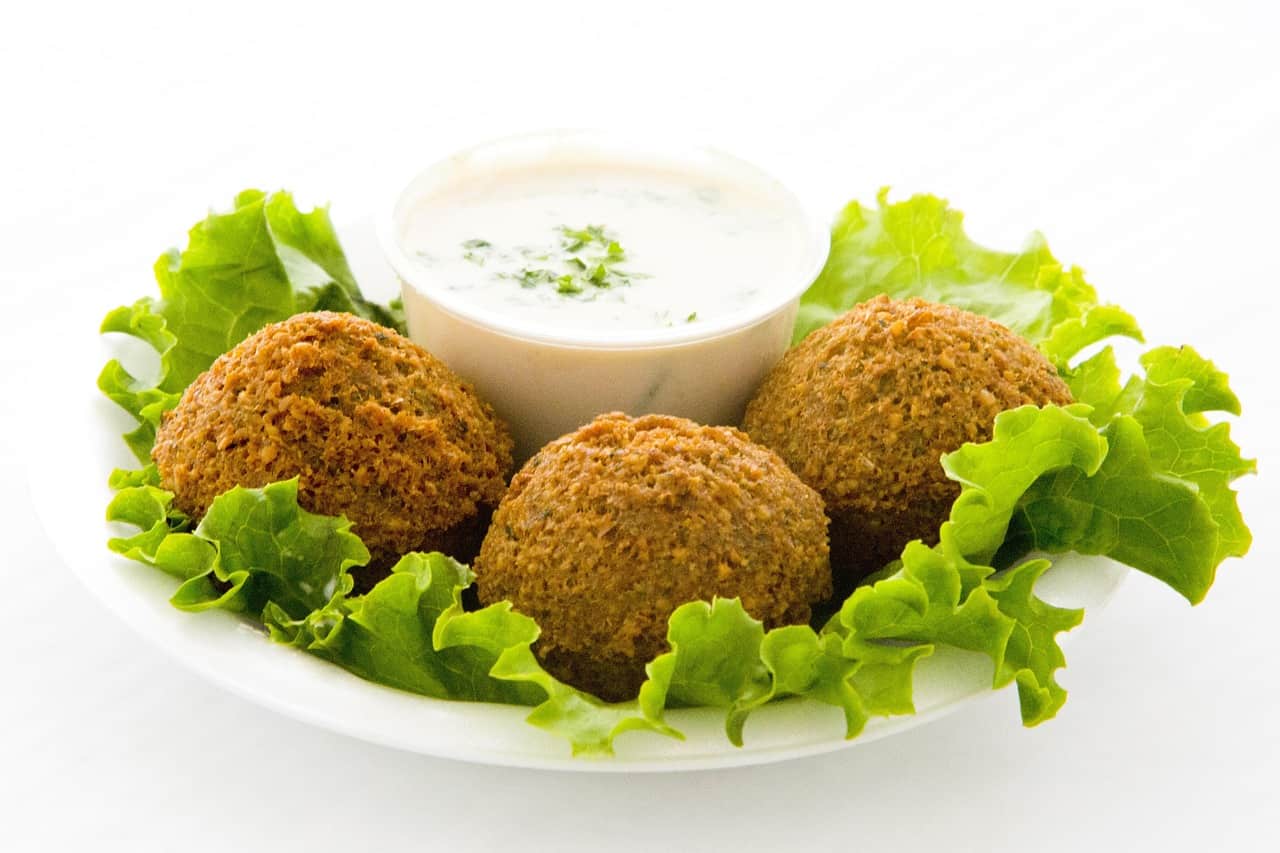Falafel is a prevalent Middle Eastern dish made from ground chickpeas (and sometimes fava beans), onions, spices, and herbs. The mixture is shaped into balls or patties and then deep-fried until crispy and golden brown.

Ratings 05

What Is The Falafel
01. What Makes Falafel Special?
- Plant-based: Completely vegetarian and often vegan.
- Crispy outside, soft inside: The texture is one of its signature features.
- Uses spices like cumin and coriander together with flavoured herbs like cilantro and parsley.
- Versatile: Can be eaten in pita sandwiches, wraps, salads, or as a snack with dips like hummus or tahini.
02. Common Serving Styles
- In pita bread with lettuce, tomato, and sauces like tahini or yogurt.
- As part of a mezze platter with hummus, baba ganoush, pickles, and tabbouleh.
- As a salad topping for a protein-rich meal.
Health Benefits Of Falafel
Falafel offers several health benefits, especially when it’s prepared with wholesome ingredients and cooked in a healthy way (like baking or air-frying). Here’s a breakdown:
01. Rich In Plant-Based Protein
- Chickpeas are an excellent source of protein, which supports muscle repair and growth.
- Ideal for vegetarians and vegans as a meat alternative.
02. High In Dietary Fiber
- Helps improve digestion, promotes regular bowel movements, and keeps you feeling full longer.
- Aids in blood sugar regulation.
03. Packed With Antioxidants
- Herbs like parsley and cilantro are rich in vitamins A and C, which support immunity and reduce inflammation.
04. Good Source Of Complex Carbohydrates
- Chickpeas provide slow-digesting carbs that offer steady energy without spikes in blood sugar.
05. Contains Healthy Fats
- When made with minimal oil or baked, falafel can be a low-fat option.
- When deep-fried in healthy oils (like canola or avocado oil), it contains unsaturated fats that support heart health.
06. Nutrient-Rich
- Provides iron, magnesium, folate, and zinc, all important for energy production, immune function, and overall well-being.
07. Things To Watch
- Deep-frying increases calorie and fat content significantly.
- Some store-bought or restaurant versions may include additives or be overly salty.
08. Healthy Tip
- For a lighter version, bake or air-fry falafel and serve it with whole grain pita, fresh veggies, and tahini or yogurt sauce.
Tips For Making Falafel
Here are some essential tips for making perfect falafel — crispy on the outside, fluffy and flavorful on the inside:
01. Always Use Dried Chickpeas (Not Canned)
- Soak dried chickpeas overnight (12–24 hours).
- Do not cook them — this helps falafel stay crisp and hold shape better than using canned chickpeas, which are too soft.
02. Drain Chickpeas Thoroughly
- After soaking, drain well to avoid excess moisture that can make the falafel soggy or fall apart.
03. Chill The Mixture
- After blending, pour the mixture into the fridge for at least 30 to 60 minutes.
- It helps the ingredients firm up and bind better when frying or baking.
04. Don’t Overprocess The Mixture
- Pulse in a food processor until coarse, like damp sand or couscous.
- Over-blending creates a paste that can be dense or gummy.
05. Add Binding Only If Needed
- Add flour or chickpea flour (besan) only if the mixture doesn’t hold together.
- Falafel, which includes too much flour, could become cakey and dry.
06. Use Baking Soda For Lightness
- A small amount of baking soda helps the falafel puff up and stay fluffy inside.
07. Test A Small Ball First
- Fry or bake one test falafel to check if it holds together and tastes good. Adjust spices or texture if needed.
08. Keep Oil Hot When Frying
- Maintain oil at around 350°F (175°C).
- If too cool: falafel will absorb oil and become greasy.
- If too hot: outside will burn before the inside cooks.
09. Use Neutral Oil
- For frying, use neutral oils like canola, vegetable, or sunflower oil with a high smoke point.
10. Serve Immediately For Best Texture
- Falafel is best enjoyed hot and fresh for maximum crispiness and flavor.
FAQ Falafel
Here are some frequently asked questions (FAQ) about falafel with clear and helpful answers:
01. Can I Use Canned Chickpeas For Falafel?
A: It is not advised. Falafel may crumble because canned chickpeas are too soft and wet. For optimal results, use dried chickpeas that have been soaked overnight.
02. Can Falafel Be Baked Or Air-Fried Instead Of Deep-Fried?
A: Yes! For a healthier option
- Bake for 25 to 30 minutes at 375°F (190°C), turning halfway through.
- Air-fry at 375°F (190°C) for 10–15 minutes until crispy.
03. Why Is My Falafel Falling Apart During Frying?
A: Common reasons
- Using canned chickpeas
- Mixture too wet
- Not chilled enough
- Not enough binding (add a little flour if needed)
04. Can I Freeze Falafel?
A: Yes
- Uncooked: Shape into balls/patties, freeze on a tray, then store in a bag.
- Cooked: Before freezing, leave to cool. Reheat in the oven or air fryer for the best texture.
05. Is Falafel Gluten-Free?
- A: Yes, if made without wheat flour. Use chickpea flour or other gluten-free binders instead.
06. What Sauces Go Well With Falafel?
A: Popular options
- Tahini sauce
- Garlic yogurt sauce
- Hummus
- Hot sauce or harissa
07. What Do You Serve With Falafel?
A: Serve in
- Pita bread or wraps
- Bowls with salad, rice, or grains
- Mezze platters with hummus, pickles, olives, and veggies

Falafel
Ingredients
- 1 cup dried chickpeas (not canned)
- 1/2 large onion, roughly chopped
- 2–3 cloves garlic
- 1/2 cup fresh parsley leaves
- 1/2 cup fresh cilantro leaves
- 1 tsp ground cumin
- 1 tsp ground coriander
- 1/2 tsp baking soda
- 1 tsp salt (or to taste)
- 1/4 tsp black pepper
- 1/4 tsp cayenne pepper (optional)
- 2–3 tbsp flour or chickpea flour (if needed for binding)
- Oil for frying (vegetable or canola)
Instructions
Soak Chickpeas
- Rinse the dried chickpeas and soak them in water overnight (at least 12 hours). They will double in size. Drain them well before using.
Blend Ingredients
- In a food processor, combine soaked chickpeas, onion, garlic, parsley, cilantro, cumin, coriander, baking soda, salt, pepper, and cayenne. Pulse until the mixture is finely minced but not a paste. It should be coarse but hold together when pressed.
Rest The Mixture
- Transfer the mixture to a bowl. If it feels too loose, add a little flour. Cover and refrigerate for 30–60 minutes to firm up.
Form The Falafel
- Scoop and shape into small balls or patties (about the size of a walnut).
Heat The Oil
- Heat about 2 inches of oil in a deep pan to 350°F (175°C).
Fry Falafel
- Carefully lower the falafel into the hot oil. Fry in batches for about 3–4 minutes per side until deep golden brown and crispy.
Drain And Serve
- Remove with a slotted spoon and drain on paper towels. Serve warm in pita with tahini sauce, hummus, salad, or pickles.
-
Falafel
Falafel is a prevalent Middle Eastern dish made from ground chickpeas (and sometimes fava beans), onions, spices, and herbs. The mixture is shaped into balls or patties and then deep-fried until crispy and golden brown. Ratings 05 What Is The Falafel 01. What Makes Falafel Special? 02. Common Serving Styles Health Benefits Of Falafel Falafel…


Leave a Comment